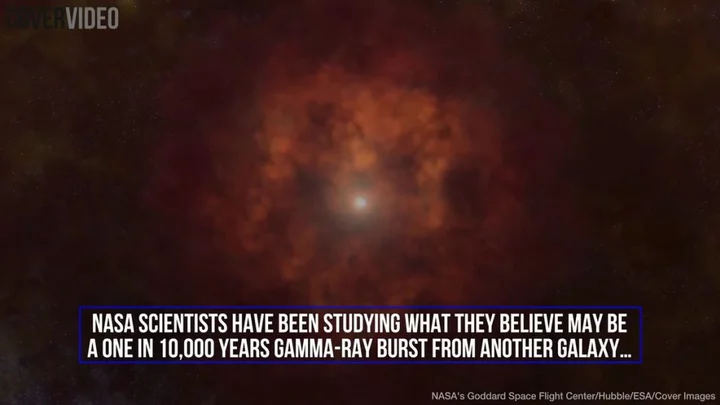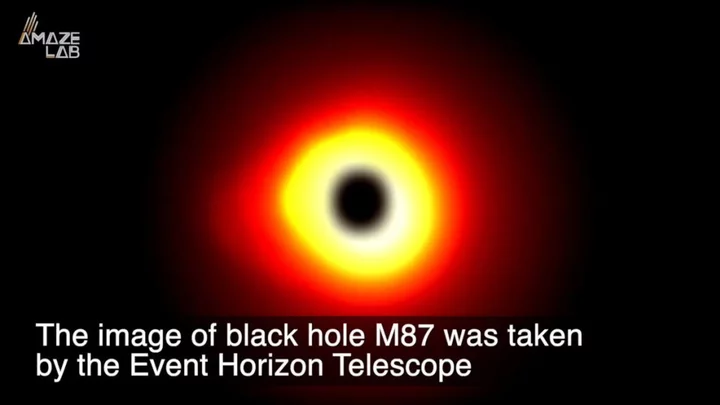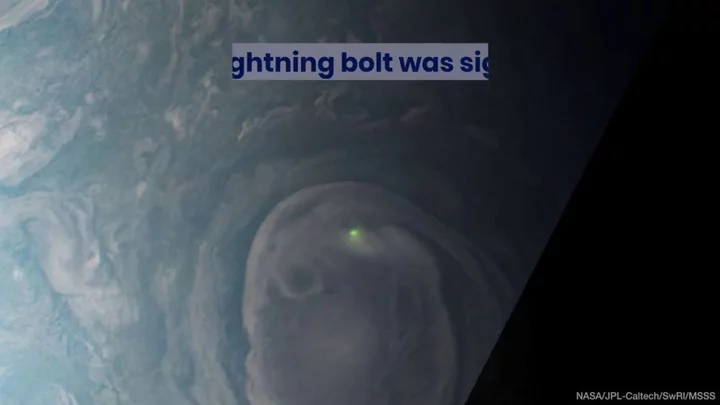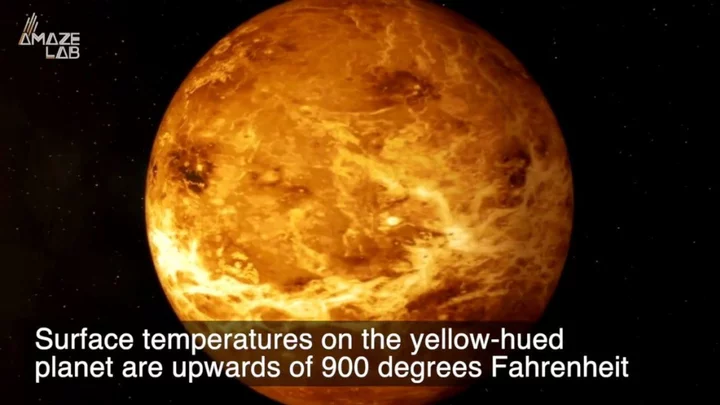
Astronomers discover a totally new way that stars can die
Astronomers have discovered a new way that stars can die. In a study published in the journal Nature Astronomy, experts have worked out that a minute-long gamma-ray burst of light, which occured in 2019 and evidence a star dying, happened because stars collided within the densely crowded environment near the supermassive black hole at the centre of an ancient galaxy. Normally gamma-ray bursts (GRB) last around two seconds and happen when stars collapse. “For every hundred events that fit into the traditional classification scheme of gamma-ray bursts, there is at least one oddball that throws us for a loop,” said study coauthor Wen-fai Fong, assistant professor of physics and astronomy at Northwestern University’s Weinberg College of Arts and Sciences, in a statement. “However, it is these oddballs that tell us the most about the spectacular diversity of explosions that the universe is capable of.” Over time, astronomers have observed three main ways that stars can die, depending on their size. Lower mass stars like our sun shed their outer layers as they age, eventually becoming dead white dwarf stars. Sign up to our free Indy100 weekly newsletter Massive stars burn through the fuel-like elements at their core and shatter in explosions called supernovas. Doing so can leave behind dense remnants like neutron stars or result in the creation of black holes. A third form of star death results when neutron stars or black holes begin to orbit one another in a binary system and spiral closer to one another until they collide and explode. But the new observation suggests a fourth type of death. “Our results show that stars can meet their demise in some of the densest regions of the universe, where they can be driven to collide,” said lead study author Andrew Levan, an astrophysics professor at Radboud University in Nijmegen, Netherlands, in a statement. “This is exciting for understanding how stars die and for answering other questions, such as what unexpected sources might create gravitational waves that we could detect on Earth.” “The lack of a supernova accompanying the long GRB 191019A tells us that this burst is not a typical massive star collapse,” said study coauthor Jillian Rastinejad, a doctoral student of astronomy at Northwestern, in a statement. “The location of GRB 191019A, embedded in the nucleus of the host galaxy, teases a predicted but not yet evidenced theory for how gravitational-wave emitting sources might form.” “While this event is the first of its kind to be discovered, it’s possible there are more out there that are hidden by the large amounts of dust close to their galaxies,” said Fong, who is also a member of the Center for Interdisciplinary Exploration and Research in Astrophysics at Northwestern. “Indeed, if this long-duration event came from merging compact objects, it contributes to the growing population of GRBs that defies our traditional classifications.” You learn something new every day. Have your say in our news democracy. Click the upvote icon at the top of the page to help raise this article through the indy100 rankings.
2023-06-26 19:26

Scientists have come up with a new meaning of life – and it's pretty mind-blowing
The meaning of life is the ultimate mystery – why do we exist? And is there a point to… well… anything? These are questions to which we may never find answers, but at least we can define what “life” means in scientific terms. And yet, our understanding of what life is is changing all the time, thanks to space exploration. As scientists continue to hunt for life beyond our own world, biologists are having to rethink the meaning of the word “life” itself. Sign up for our free Indy100 weekly newsletter Generally, biologists explain “life” as connoting a self-sustaining chemical system which is capable of performing functions such as eating, metabolising, excreting, breathing, moving, growing, reproducing, and responding to external stimuli. This definition works pretty well here on Earth (although there are some important exceptions, such as viruses), but experts have pointed out that if life exists elsewhere in the universe, it may not display the same properties that we’re used to. Indeed, it might be unrecognisable as life as we know it (forget those little green men). In which case, how will we spot it if it ever crosses our path? Astrobiologist Sara Imari Walker and chemist Lee Cronin think they’ve come up with a solution. The pair are now arguing that highly complex molecules found in all living creatures can’t exist thanks purely to chance. Therefore, they say, the universe must have a way of creating and reproducing complex information and retaining a “memory” of all of this.. In an interview with New Scientist, Walker, of Arizona State University, explained their radical idea on how objects come into existence. The concept, known as Assembly Theory, explains why certain complex objects have become more abundant than others by considering their histories. If the theory proves correct, it will redefine what we mean by “living” things and show that we’ve been going about the search for extraterrestrial life all wrong. In the process, we could even end up creating alien life in a laboratory, she stressed. In her discussion with New Scientist, Walker pointed out: "An electron can be made anywhere in the universe and has no history. You are also a fundamental object, but with a lot of historical dependency. You might want to cite your age counting back to when you were born, but parts of you are billions of years older. "From this perspective, we should think of ourselves as lineages of propagating information that temporarily finds itself aggregated in an individual." Assembly theory predicts that molecules produced by biological processes must be more complex than those produced by non-biological processes, as Science Alert notes. To test this, Walker and her team analysed a range of organic and inorganic compounds from around the world and outer space, including E. coli bacteria, urine, meteorites and even home-brewed beer. They then smashed up the compounds into smaller pieces and used mass spectrometry to pinpoint their molecular building blocks. They calculated that the smallest number of steps required to reassemble each compound from these building blocks was 15. And whilst some compounds from living systems needed fewer than 15 assembly steps, no inorganic compounds made it above this threshold. "Our system … allows us to search the universe agnostically for evidence of what life does rather than attempting to define what life is," Walker, Cronin, and others wrote in a 2021 Nature Communications article. The handy thing about this building block system – which they’ve dubbed the “'molecular assembly index” – is that it doesn’t rely on carbon-based organic materials to be identified. In other words, an alien could be made of entirely different stuff entirely and we’d still be able to spot it as life using the index. It also works regardless of what stage of “life” an extraterrestrial being is in – whether it is still in its infancy or has moved into a technological stage beyond our understanding. That’s because all of these states produce complex molecules which couldn’t exist in the absence of a living system. If all of this is hurting your head, let’s just get back to the basics: if there is a secret to life, it might all be down to what we do, not what we are. Have your say in our news democracy. Click the upvote icon at the top of the page to help raise this article through the indy100 rankings.
2023-06-25 19:17

Heartbeat sensors on shopping trolleys 'could save lives', new study suggests
New findings have suggested that adding sensors to supermarket trolleys could save people’s lives. Scientists investigated whether installing electrocardiogram (ECG) sensors – designed to check the heart’s rhythm – on the handles of supermarket, trolleys could identify shoppers with atrial fibrillation, which causes an irregular and often abnormally fast heart rate. The sensors would detect heart conditions that put them at increased risk of stroke. The researchers said that over the course of two months, they identified 39 people who were unaware that they had the condition. Ian Jones, professor of cardiovascular nursing at Liverpool John Moores University, who led the study, said: “That’s 39 people at greater risk of stroke who received a cardiologist appointment.” He added: “This study shows the potential of taking health checks to the masses without disrupting daily routines.” It is estimated that around 1.5 million people in the UK have atrial fibrillation, contributing to one in five strokes. The condition is treatable, but at least another 270,000 people in the UK remain undiagnosed and unaware, according to the British Heart Foundation. Sign up for our free Indy100 weekly newsletter There are wearable devices that can also spot irregular heartbeat but this would also require people to take responsibility and wear the device. Professor Jones said: “Nearly two-thirds of the shoppers we approached were happy to use a trolley, and the vast majority of those who declined were in a rush rather than wary of being monitored. “This shows that the concept is acceptable to most people and worth testing in a larger study.” He added: “Checking for atrial fibrillation while people do their regular shopping holds promise for preventing strokes and saving lives. “A crucial aspect is providing immediate access to a health professional who can explain the findings and refer patients on for confirmatory tests and medication if needed.” The findings were presented at ACNAP 2023 conference organised by the European Society of Cardiology (ESC). Have your say in our news democracy. Click the upvote icon at the top of the page to help raise this article through the indy100 rankings.
2023-06-25 16:59

Inside Titanic director James Cameron's obsession with the deep ocean
Public interest in the deep ocean went into a frenzy this week as the search for the doomed Titan submarine played out – and Oscar-winning film director has made no secret of the fact that he is obsessed with the subject. Since it emerged on 22 June that the Titan was destroyed in what US authorities called a “catastrophic implosion”, Cameron has been telling media outlets that he knew what the five-man crew’s fate was since Monday, four days earlier. After calling up his “contacts in the deep submersible community” Cameron said he had already ascertained that the vessel had been destroyed in an implosion. “I felt in my bones what had happened.” Sign up to our free Indy100 weekly newsletter But why does Cameron know so much about the ocean depths? Titanic, Avatar and The Abyss First of all, Cameron has made a lot of films about the bottom of the sea. His 1997 film, Titanic, won 11 Oscars and was the first movie to earn more than $1bn worldwide, and Cameron went deep on his research – literally. The filmmaker has visited the real-life wreck of the Titanic 33 times, making his first trip in 1995 to shoot footage for the film. One of those dives even involved getting trapped with the wreck for 16 hours, with currents of water holding the director’s submarine at the bottom of the ocean. He has even written a book about his experiences, Exploring The Deep, which includes details of his dive journey, photos and maps from his own explorations of the wreck. He told ABC News: “I actually calculated [that] I've spent more time on the ship than the captain did back in the day.” Long before Titanic, Cameron directed The Abyss in 1989. The premise of the film is that an American submarine sinks in the Caribbean – sound familiar? That prompts a search and recovery team to race against Soviet vessels to recover the boat. Meanwhile, the last movie in Cameron’s famous Avatar franchise, The Way of Water, is set on the aquatic ecosystems of a world 25 trillion miles from Earth. "Some people think of me as a Hollywood guy … (but) I make 'Avatar' to make money to do explorations," Cameron told The Telegraph. Going even deeper In 2012, Cameron went a step further, plunging nearly 11km down to the deepest place in the ocean, the Mariana Trench in the western Pacific. The filmmaker made the solo descent in a submarine called the Deepsea Challenger, and it took more than two hours to reach the bottom. The submarine he used was years in the making, designed by Cameron himself with a team of engineers. The trip was only the second manned expedition to the Mariana Trench. The first was in 1960, when US Navy Lieutenant Don Walsh and Swiss scientist Jacques Piccard descended to the ocean floor. “It was absolutely the most remote, isolated place on the planet,” Cameron said in a later interview. “I really feel like in one day I've been to another planet and come back.” He was even underwater when 9/11 happened His obsession with the ocean goes back to age 17, he told the New York Times, when he learned to scuba dive, when he said he felt like he had discovered the "keys to another world”. And between making Titanic in 1997 and Avatar in 2009 Cameron didn’t make a feature film. But he did make documentaries about sea exploration. One of those, 2003’s Ghosts of the Abyss, showed Cameron's travels to the Titanic, while the other, 2005’s Aliens of the Deep, saw Cameron team up with NASA scientists to explore the sea creatures of mid-ocean ridges. Cameron’s fascination even meant he was inside a submersible vessel exploring the Titanic on 11 September 2001, when terrorists flew two passenger jets into the World Trade Centre. It was only after the now-68-year-old director and his crew finished their expedition and returned to the main ship that Cameron learned what had happened. “What is this thing that’s going on?” Cameron asked the late actor Bill Paxton, who played treasure hunter Brock Lovett in the film. “The worst terrorist attack in history, Jim,” Paxton said. Cameron realised he “was presumably the last man in the Western Hemisphere to learn about what had happened,” he told Spiegel in 2012. Have your say in our news democracy. Click the upvote icon at the top of the page to help raise this article through the indy100 rankings.
2023-06-23 20:29

Scientists discover centuries old 'echo' from supermassive black hole
The universe appears to be speaking to us, after a centuries old “echo” from a supermassive black hole was detected by scientists. The black hole located inside the Milky Way became active around 200 years ago and produced a sound that is now being studied. The research was published in Nature and focuses on the black hole named Sagittarius A* (Sgr A*) found 26,000 light-years away from Earth. The noise was triggered when the object consumed gas and dust, with particles moving into the event horizon. The findings could teach us more about the activity of supermassive black holes, which continue to intrigue and confound scientists. Sign up to our free Indy100 weekly newsletter Author of the research Dr Frederic Marin of Strasbourg University said: “It reveals the past awakening of this gigantic object – which is four million times more massive than the Sun. “Our work presents the missing piece of evidence that X-rays from the giant molecular clouds are due to reflection of an intense, yet short-lived flare produced at or nearby Sagittarius A*. These results can further constrain the past activity of the galactic centre.” By their very nature, black holes are difficult to study as they absorb light around them, and these new findings offer insight into a fascinating part of space. Dr Marin said: “To get an idea of the increase in intensity of the X-ray emission when the black hole emerged from its quiescent state, it is as if a single glow-worm hidden in a forest suddenly became as bright as the Sun. “These findings explain why galactic molecular clouds near Sgr A* are shining more brightly than usual. It is because they are reflecting the X-rays emitted by Sgr A* 200 years ago.” Have your say in our news democracy. Click the upvote icon at the top of the page to help raise this article through the indy100 rankings.
2023-06-23 19:19

4,000-year-old 'Stongehenge of the Netherlands' site revealed by scientists
A 4,000-year-old site reminiscent of Stonehenge has been uncovered in the Netherlands for the first time. The monument was uncovered by Dutch archaeologists on Wednesday (21 June), uncovering an ancient religious site that has been nicknamed the “Stonehenge of the Netherlands”. Uncovered in the dig was a burial mound containing the remains of 60 men, women and children. The mound also served as a solar calendar, with the Sun shining directly through passages on the shortest and longest days of the year. Digging at the so-called “open-air sanctuary”, located in the town of Tiel, began in 2017, but the results of the archaeologists’ findings were only recently made public. A post on the town’s Facebook page, read: “What a spectacular archaeological discovery! Archaeologists have found a 4,000-year-old religious sanctuary on an industrial site.” Sign up to our free Indy100 weekly newsletter It continued: “This is the first time a site like this has been discovered in the Netherlands.” By comparing different samples of clay and their composition, three burial mounds were located during the excavation. The mounds are located just a few kilometres from the bank of the Waal River, with the main mound measuring 20 meters wide and its passages perfectly aligned to serve as a solar calendar. One of the archaeologists explained: “People used this calendar to determine important moments including festival and harvest days.” Dutch national broadcaster, NOS, added: “This hill reminded one of Stonehenge, the well-known mysterious prehistoric monument in Britain, where this phenomenon also occurs.” Other fascinating discoveries at the site included a single glass bead found inside a grave – analysis showed it originated in Mesopotamia, which is Iraq today. Have your say in our news democracy. Click the upvote icon at the top of the page to help raise this article through the indy100 rankings.
2023-06-23 00:26

A key building block for human life has been discovered in interstellar space
One of the key building blocks required for human life has been found in the depths of space. Astronomers have been looking out into a region 1,000 light-years from Earth, known as the Perseus Molecular Complex, and they’ve found an amino acid which is essential in human growth. Tryptophan is one of the 20 amino acids required for humans to develop. Babies require it to grow and it’s also important for protein development and muscle function in adults Readings from the Spitzer telescope, which is no longer in use, were crucial to the discovery. Sign up to our free Indy100 weekly newsletter The Perseus Molecular Complex is only visible when viewed through infrared instruments, and tryptophan gives off an identifiable light reading when observed in this way. Dr Susana Iglesias-Groth is from the Instituto de Astrofísica de Canarias and was lead author on the new research. "The evidence for tryptophan in the Perseus molecular complex should encourage additional effort to identify other amino acids in this region, and in other star-forming regions,” Dr Iglesias-Groth said. “It is a very exciting possibility that the building blocks of proteins are widely present in the gas from which stars and planets form – it may be key for the development of life in exoplanetary systems.” The findings were published in the Monthly Notices of the Royal Astronomical Society. It comes after research showed that life forms could potentially be able to survive in the conditions in the clouds above Venus. The key point revolves around the presence of the biosignature gas phosphine, which is often identified as a sign of life. It also posits the idea that potential life forms on the planet could use sulphuric acid the way life forms on Earth use water. Have your say in our news democracy. Click the upvote icon at the top of the page to help raise this article through the indy100 rankings.
2023-06-22 19:21

Scientists just created a new state of matter – here's what that means
Scientists have just created an entirely new state of matter made out of subatomic particles. The bosonic correlated insulator, to be precise, is both a new material and a new state of matter, said researchers from California, Arizona and Japan. There are four fundamental states of matter, liquid, solid, gas and plasma – an electrically charged gas found in situations like stars and lightning strikes. But there are many others when you drill down to quantum level (that means at an atomic and subatomic level). The scientists said this is a new one. Sign up to our free Indy100 weekly newsletter The new material is a lattice-shaped pattern, formed from a layer of the two different types of subatomic particles: bosons and fermions. Bosons are a type of particle which is difficult for scientists to create and manipulate because they do not interact with each other. Fermions are more stable – particles such as electrons – and interact through electrostatic force. The material sees the two different types of particle combining and interacting in a new way, with the particles eventually form into a crystalline state, which in turn creates a material which has an insulating effect. “Conventionally, people have spent most of their efforts to understand what happens when you put many fermions together,” says condensed matter physicist Chenhao Jin from the University of California, Santa Barbara (UCSB). “The main thrust of our work is that we basically made a new material out of interacting bosons.” The new material doesn’t yet have any practical uses, but exotic creations like this help scientists understand how the universe is put together, the team said. “What happened here is that we discovered the correlation that drove the bosons into a highly ordered state,” said physicist Richen Xiong, from UCSB. The scientists think the discovery could lead to them finding more materials like this further down the line. “We know that some materials have very bizarre properties,” said Xiong. “And one goal of condensed matter physics is to understand why they have these rich properties and find ways to make these behaviours come out more reliably.” Have your say in our news democracy. Click the upvote icon at the top of the page to help raise this article through the indy100 rankings.
2023-06-22 18:24

Elon Musk branded 'cowardly' for trying to ban 'cisgender' by researcher who coined the term
The researcher who invented the term 'cisgender' has hit back at "cowardly" Elon Musk for calling the term a slur. 'Cis' or 'cisgender' was coined by now-retired researcher Dana Defosse. They are used to describe someone whose gender identity aligns with the sex they were assigned at birth. It is not offensive or intended to be used as an insult. Defosse first used the term in a 1994 internet forum, before being added to the Oxford English Dictionary much later in 2015. In an essay for HuffPost, Defosse explained how she invented the term: "I knew that in chemistry, molecules with atoms grouped on the same side are labelled with the Latin prefix ‘cis–,’ while molecules with atoms grouped on opposite sides are referred to as ‘trans–.’ So, cisgender. It seemed like a no-brainer," she wrote. On Wednesday (21 June), Musk responded to a user who claimed to have been harassed by trans rights activists. Twitter user James Esses said he "rejected" the terms after receiving "a slew of messages from trans activists calling me ‘cissy’ and telling me that I am ‘cis’ ‘whether or not I like it.’" In response, Musk tweeted: "Repeated, targeted harassment against any account will cause the harassing accounts to receive, at minimum, temporary suspensions. The words “cis” or “cisgender” are considered slurs on this platform." Sign up for our free Indy100 weekly newsletter The tech mogul's response left many social media users baffled, with Defosse saying it came as no surprise after his "ghastly history of attacking trans people." “The post on Twitter has degenerated into a sort of free-for-all for antisemitic and racist tropes, so it sort of fits in with the direction that platform is going," Defosse said. "The fact is, whether or not somebody identifies as cisgender doesn’t negate the fact that cisgender identity is a valid construct. It exists, and it has meaning in how we operate in the world." The retired researcher went on to call his censorship attempt "cowardly". "Banning use of a word that’s part of our daily vocabulary around the world, that appears in the Oxford English Dictionary, it’s a cowardly and futile attempt to censor an idea which is, in my opinion, way bigger and more enduring than anything Musk could hope to offer," she added. Have your say in our news democracy. Click the upvote icon at the top of the page to help raise this article through the indy100 rankings.
2023-06-22 16:25

New discovery on Venus points towards signs of life
Life forms could potentially be able to survive in the conditions in the clouds above Venus – although, to be honest, we don’t want to be the ones who go there and have to test this theory out. Venus has fascinated scientists for years due to the relative similarities between the planet and Earth. The surface of Venus now is around 475 degrees Celsius, but its geology resembled Earth’s before the greenhouse effect took hold over millions of years. To add to that, the surface is also covered in sulphuric acid, so the chances of it being able to foster life is slim to say the least. Sign up to our free Indy100 weekly newsletter However, new research has looked into the conditions in the clouds above the surface and the findings have been published in the journal Astrobiology. The key point revolves around the presence of the biosignature gas phosphine, which is often identified as a sign of life. It also posits the idea that potential life forms on the planet could use sulphuric acid the way life forms on Earth use water. The paper reads: "Although we consider the prospects for finding life on Venus to be speculative, they are not absent. "The clouds can support a biomass that could readily be detectable by future astrobiology-focused space missions from its impact on the atmosphere." It goes on: “We conclude that Venus' aerial biosphere must be much smaller than the Earth's. However, even such scarce, strictly aerial life could leave a detectable mark on the chemistry of the atmosphere in the clouds… “We conclude that terrestrial precedent exists for mechanisms that could keep at least some life-containing cloud particles aloft on Venus, and it prevents the entire ecology from inevitably falling to its doom in the hot, lower layers of the atmosphere.” Have your say in our news democracy. Click the upvote icon at the top of the page to help raise this article through the indy100 rankings.
2023-06-21 22:53

Elon Musk now considers 'cisgender' to be a slur
Elon Musk tweeted on Wednesday that the words “cis” and “cisgender” are now considered slurs on Twitter. The CEO and billionaire tweeted the announcement shortly after midnight ET on Wednesday in response to a user who claimed to have been harassed by trans rights activists. James Esses tweeted on Tuesday saying he ‘rejected’ the word ‘cis’ and received “a slew of messages from trans activists calling me ‘cissy’ and telling me that I am ‘cis’ ‘whether or not I like it.’” Cisgender refers to anyone whose gender identity aligns with the sex they were assigned at birth. Sign up to our free Indy100 weekly newsletter Despite the claims from many anti-trans activists that the term cisgender is relatively new, the Oxford English Dictionary notes that the term became popular back in the 1990s. This isn’t the first time the billionaire has promoted anti-trans sentiment. In April, Musk removed Twitter’s previous ban on deadnaming transgender individuals. A move that was denounced by LGBT+ advocacy organisation GLAAD. Some have speculated that much of Musk’s promotion of anti-trans views and rhetoric is related to his estranged daughter, who is trans. Many have criticised Musk’s announcement: Despite Musk’s announcement that ‘cis’ and ‘cisgender’ are now considered slurs, there has been no update to Twitter’s official guidelines. It is also not clear what the consequences are for using such terms. However, many have been quick to point out that Musk’s announcements haven’t always followed through or been implemented. Have your say in our news democracy. Click the upvote icon at the top of the page to help raise this article through the indy100 rankings.
2023-06-21 18:48

Study finds that conservative politicians are ‘happier and more attractive’
Conservative female politicians look happier and more attractive in pictures than liberals, according to artificial intelligence. A study conducted in Denmark and published in Scientific Reports found that those on the right were more likely to have happier facial expressions, whereas liberals looked more neutral. The scientists inputted some 3,200 photos of political candidates who ran in the 2017 Danish municipal election into Microsoft Azure’s Face API tool to assess the person’s emotional state. The analysis found 80 per cent of the faces displayed a happy expression, while 19 per cent read as neutral. “For females (though not males), high attractiveness scores were found among those the model identified as likely to be conservative,” read the findings. “These results are credible given that previous research using human raters has also highlighted a link between attractiveness and conservatism.” Sign up to our free Indy100 weekly newsletter Meanwhile, left-leaning male politicians showed more neutral, less happy faces than their conservative counterparts, the study found. “Attractiveness was not the only correlate of model-predicted ideology,” the scientists explained. “We also found that expressing happiness is associated with conservatism for both genders. “Previous work has found smiling in photographs to be a valid indicator of extraversion,” they continued. “And while extraversion is not broadly associated with ideology some studies have found that right-wing politicians are more extraverted.” Scientists noted that “because attractiveness generally helps electoral success, all candidates are incentivised to provide an attractive photograph.” “Politicians on the left and right may have different incentives for smiling — for example, smiling faces have been found to look more attractive which is comparatively important for conservative politicians,” the paper reads. “Future work is needed to explore the extent to which happy faces are indicative of conservatism outside of samples of politicians." Have your say in our news democracy. Click the upvote icon at the top of the page to help raise this article through the indy100 rankings.
2023-06-21 16:57
